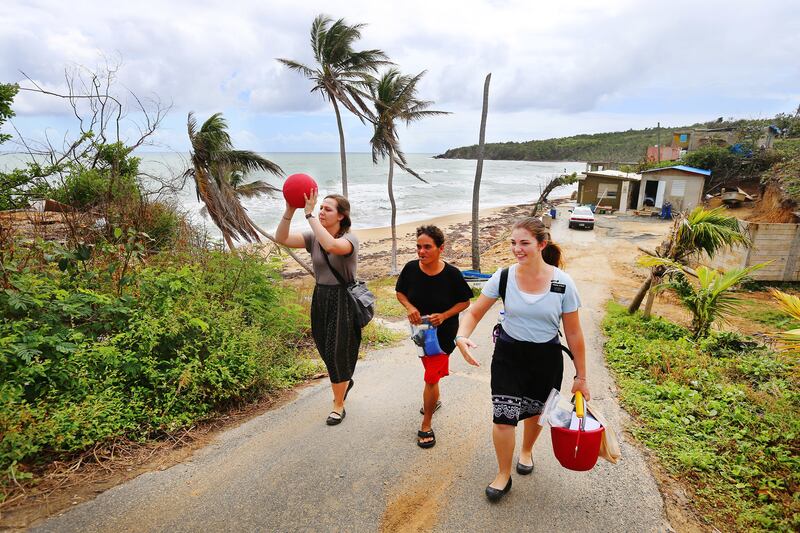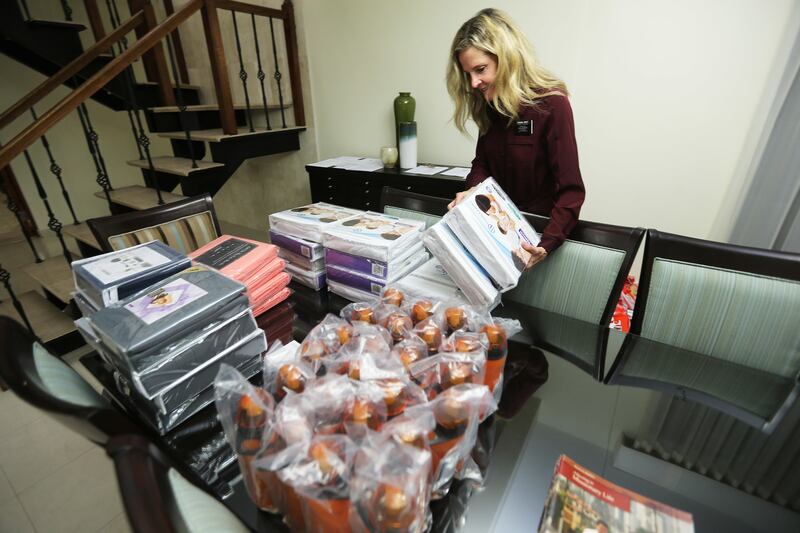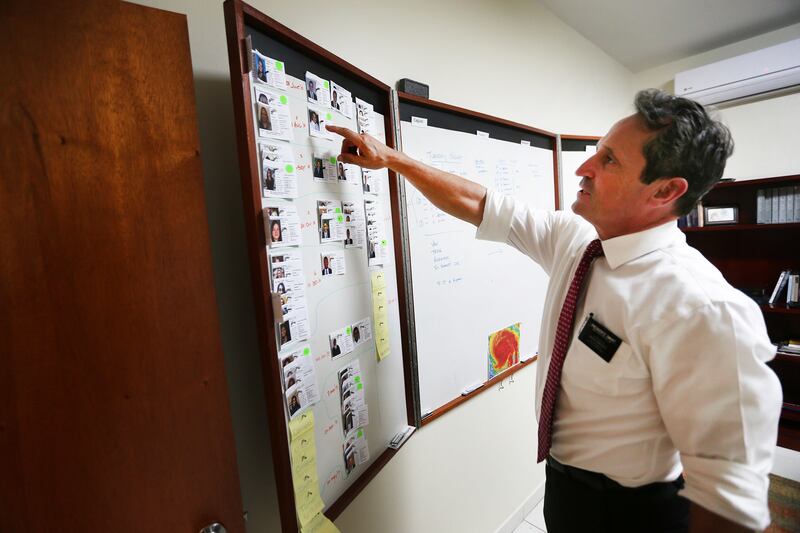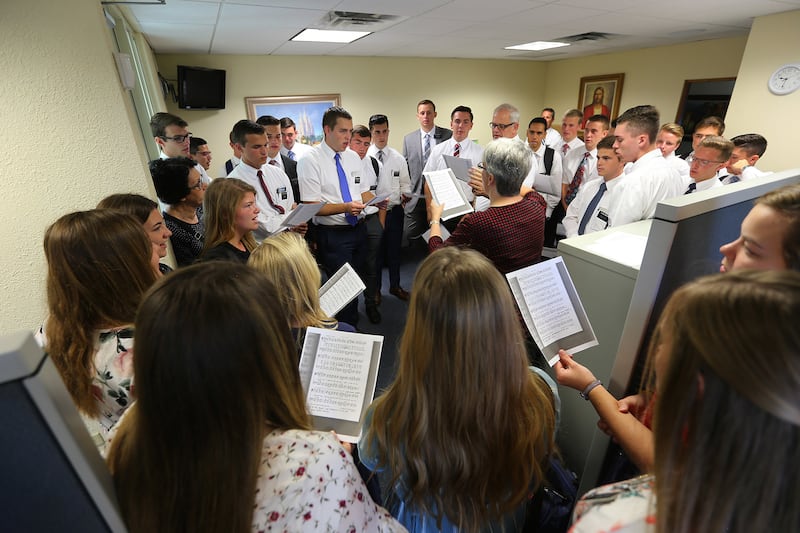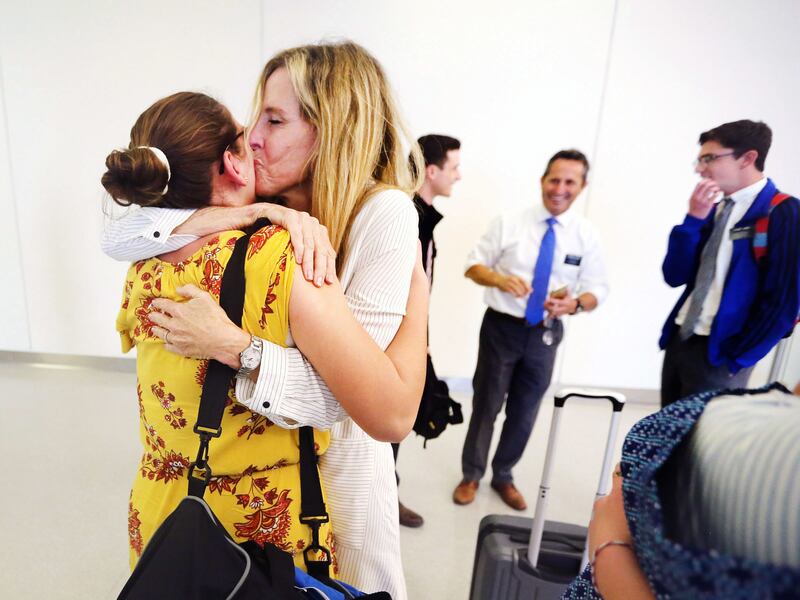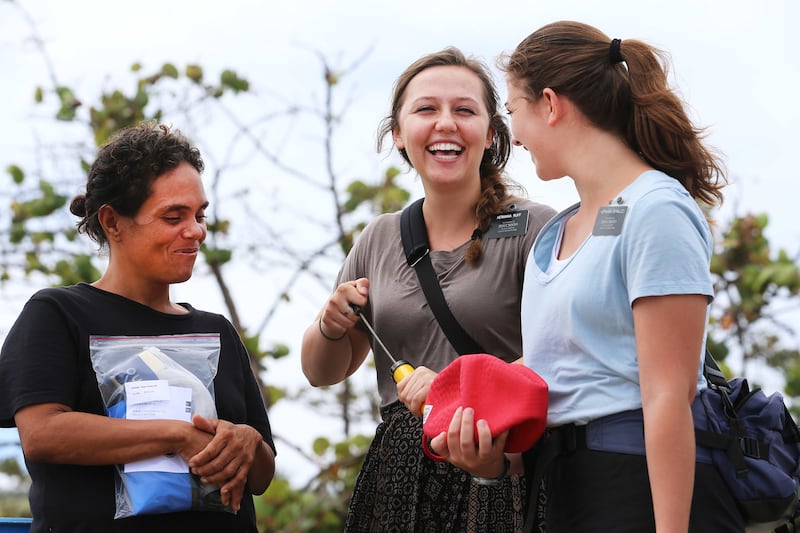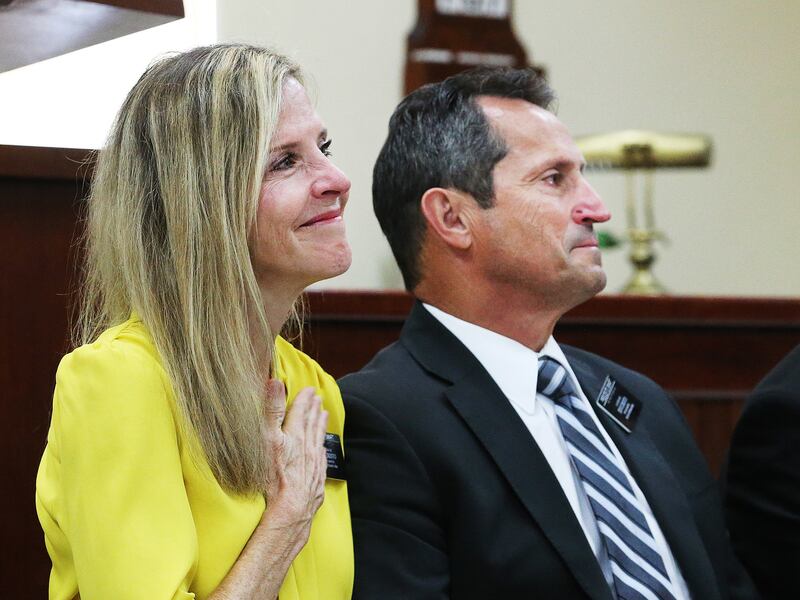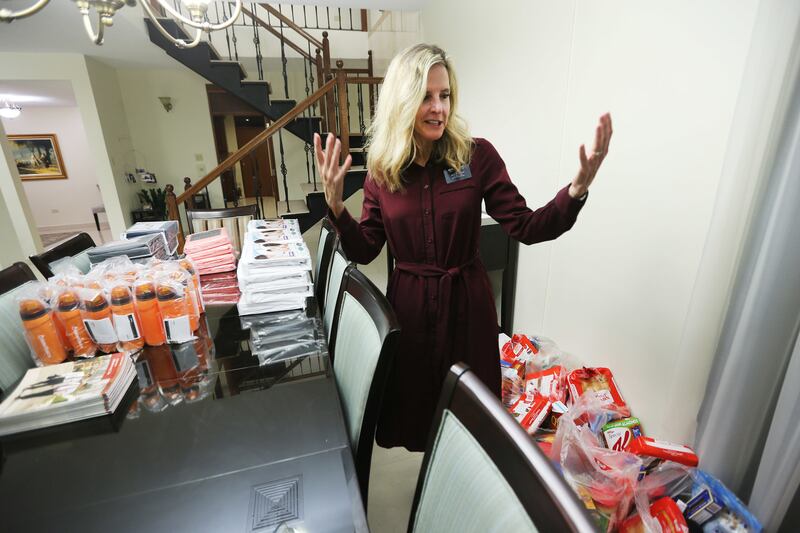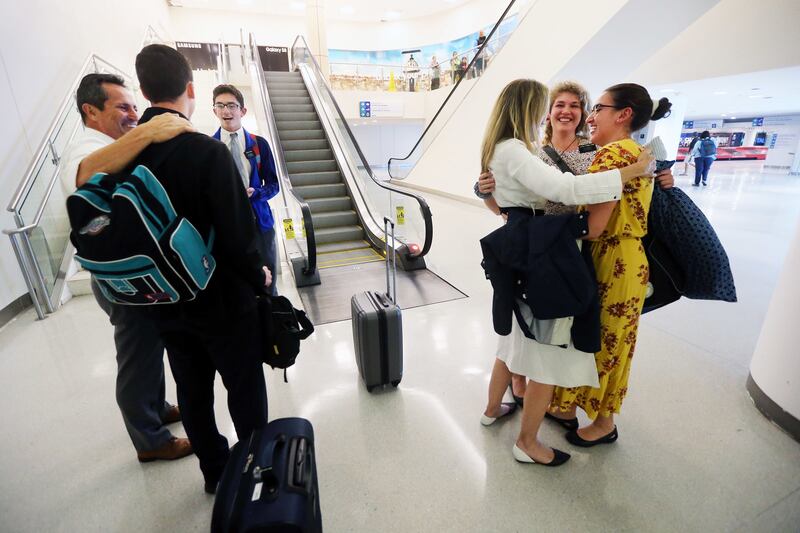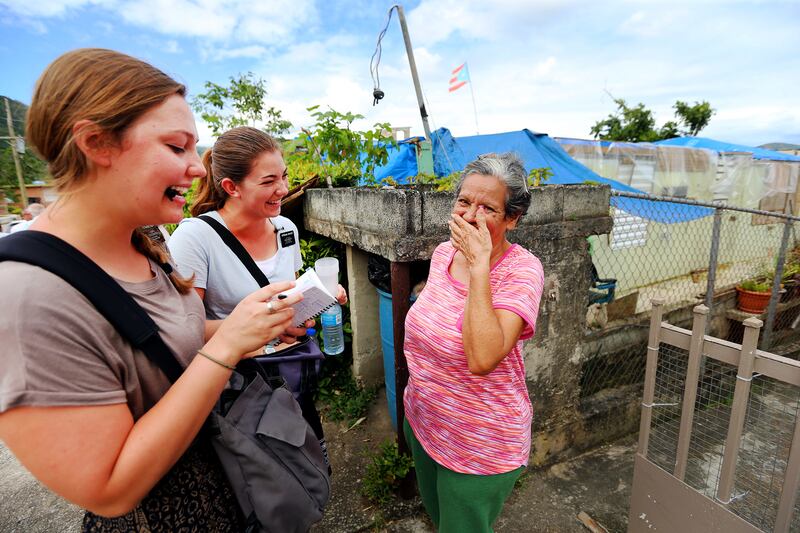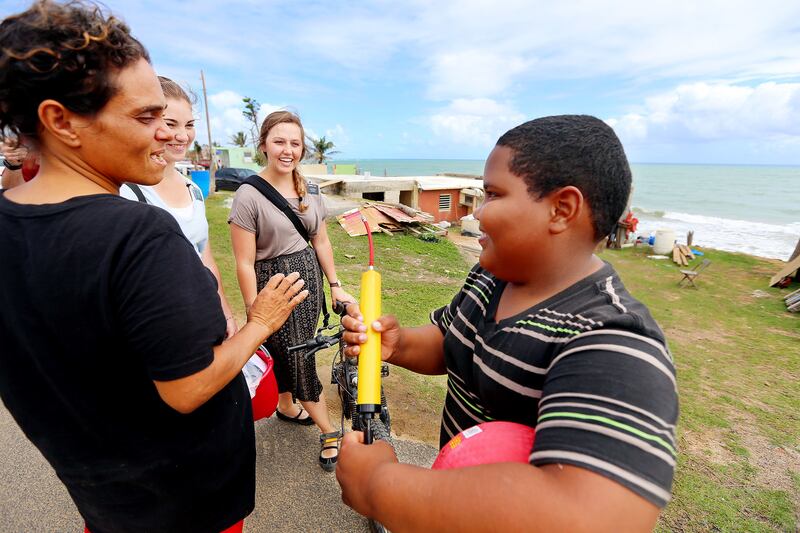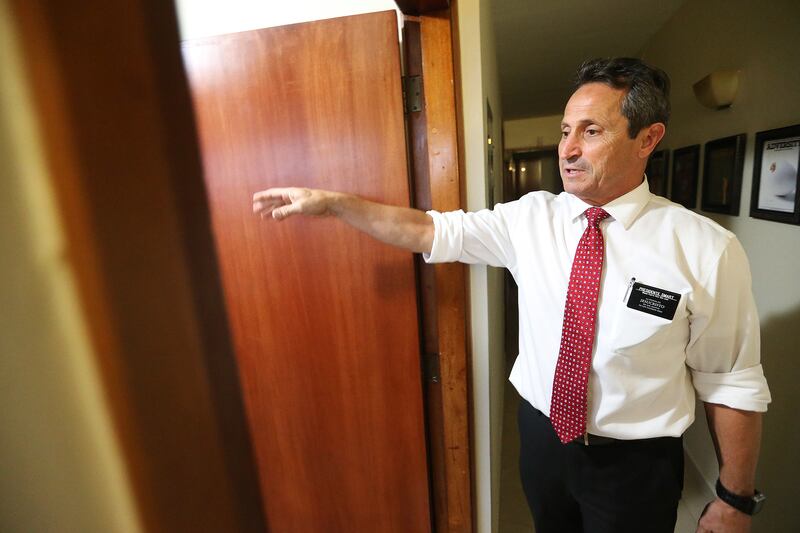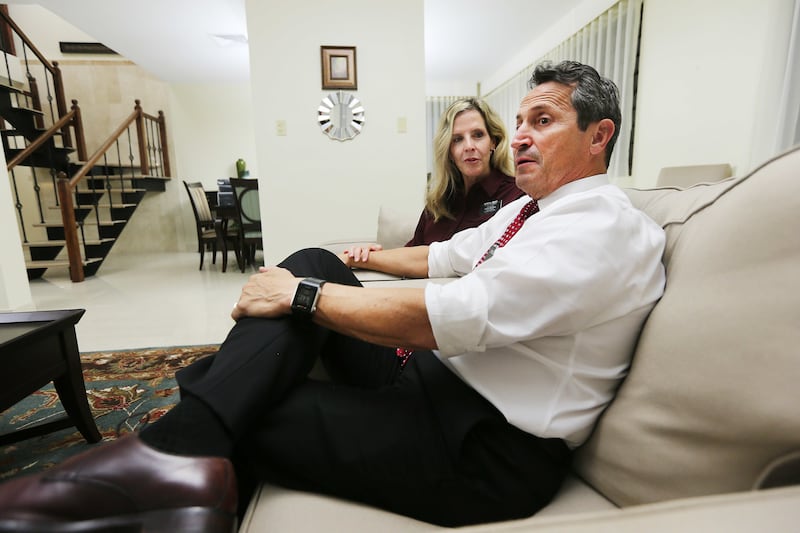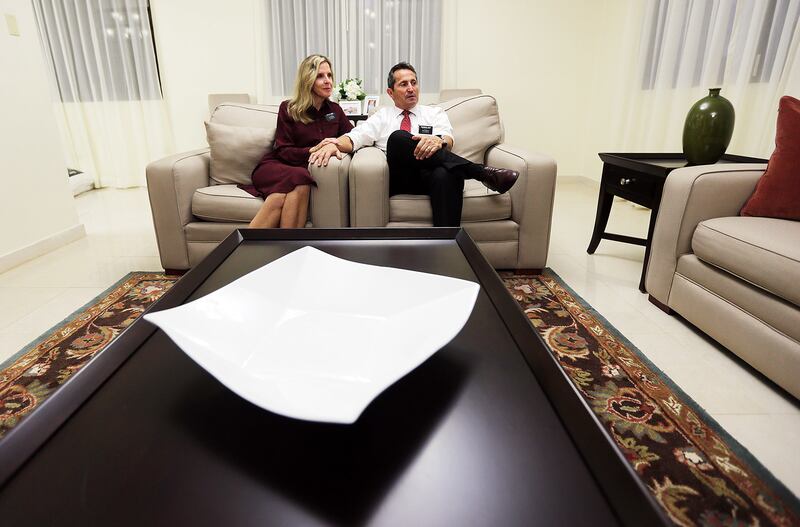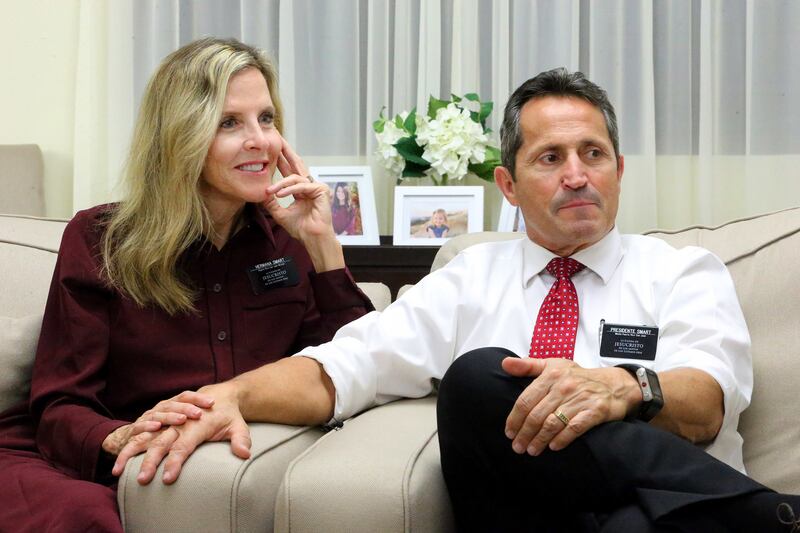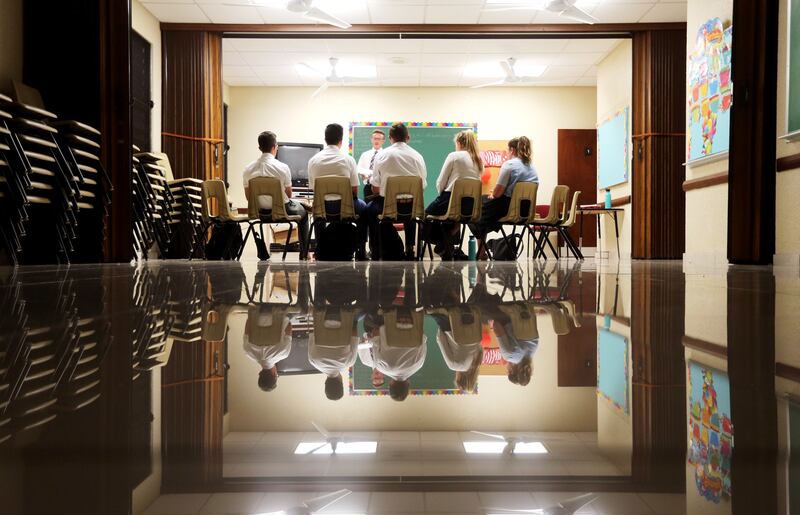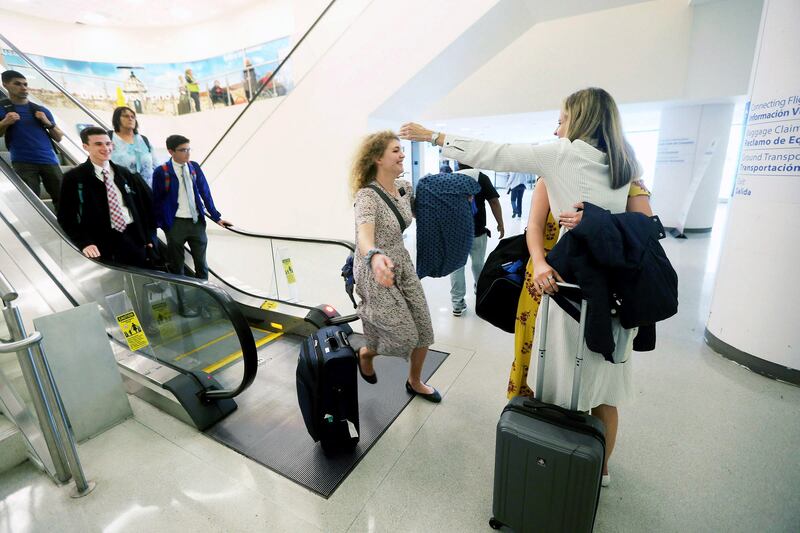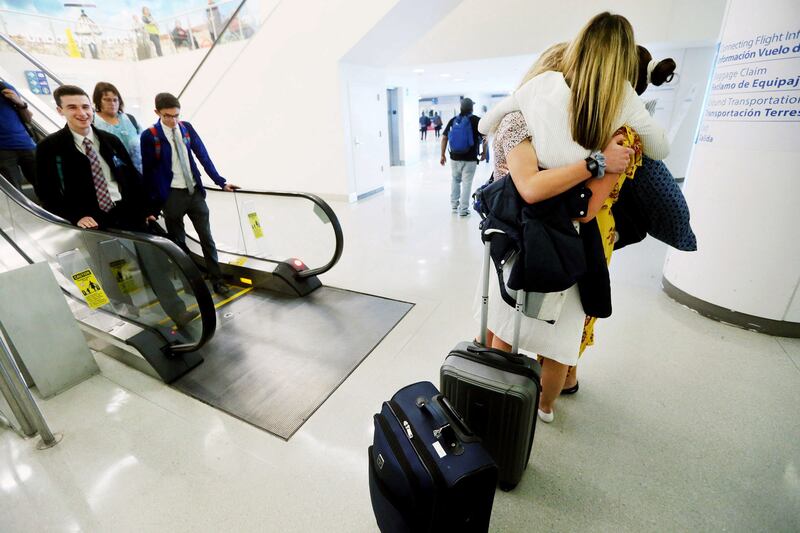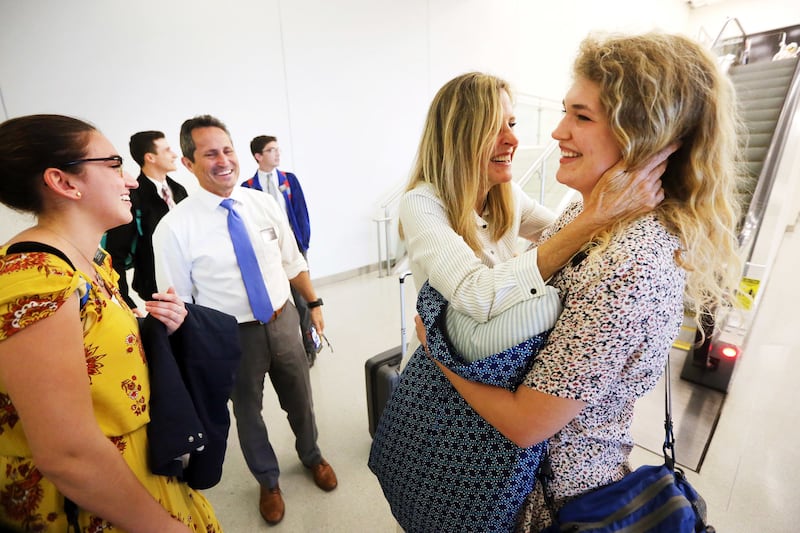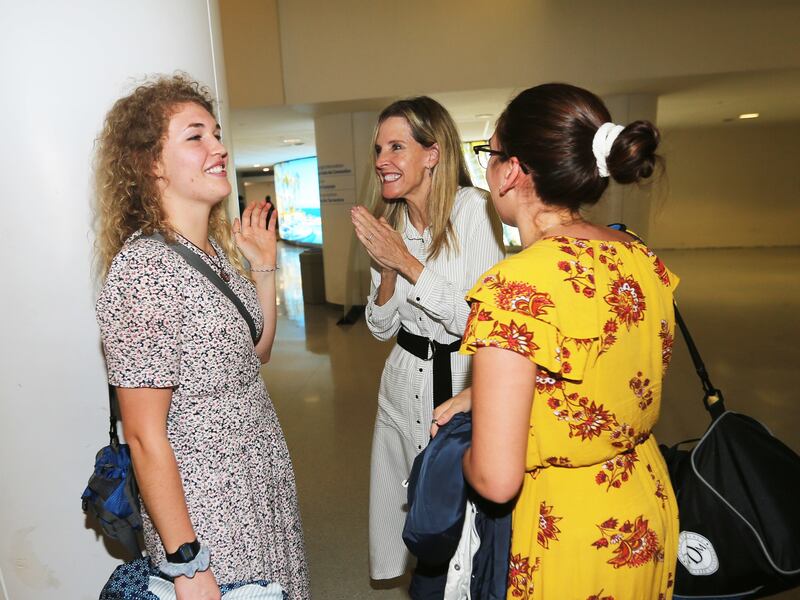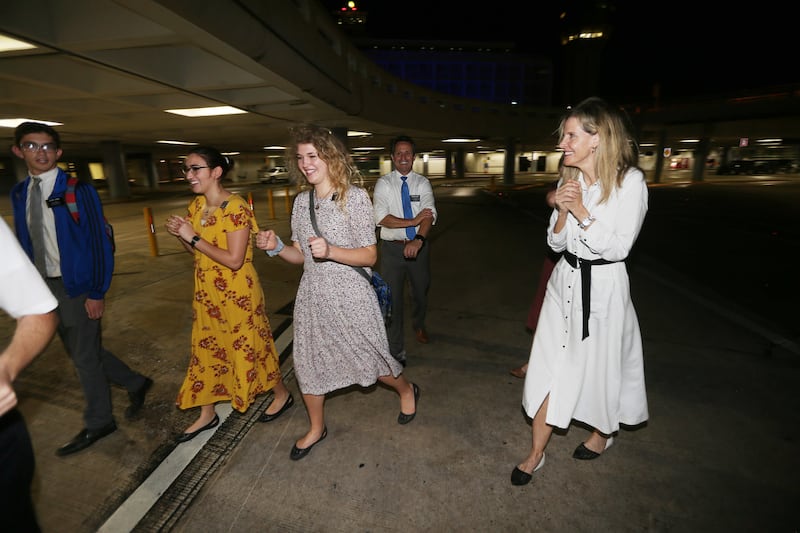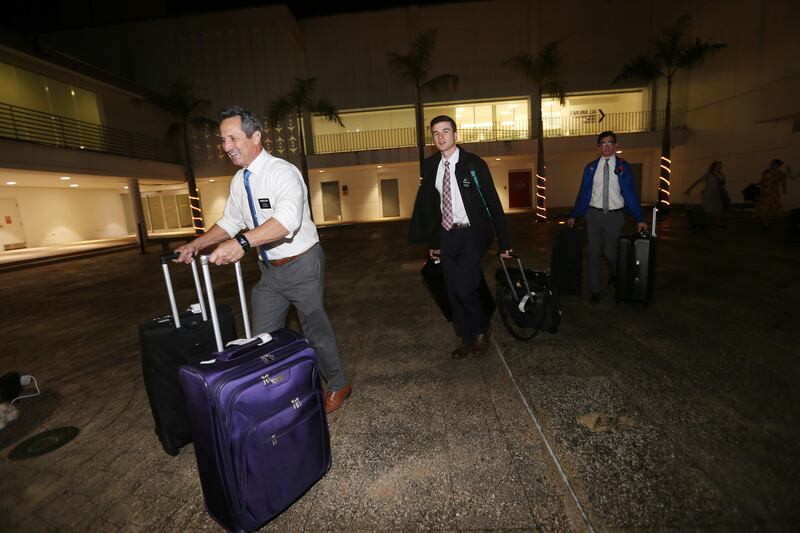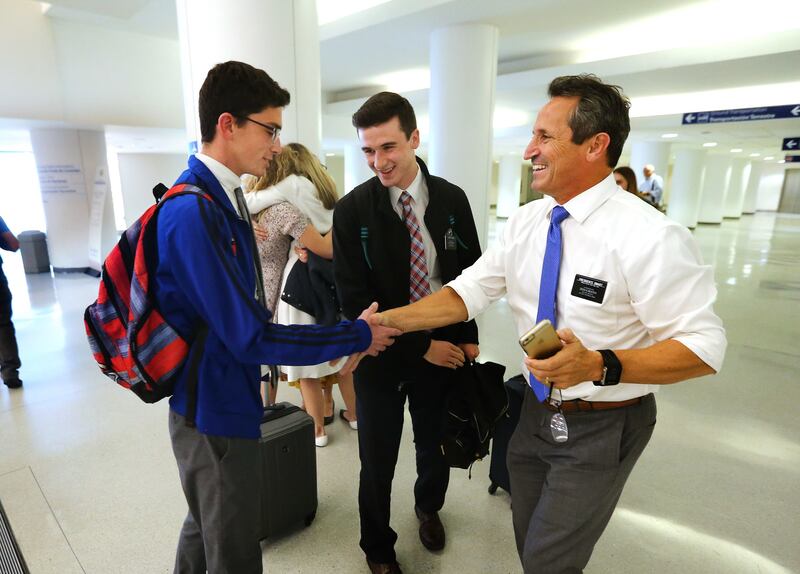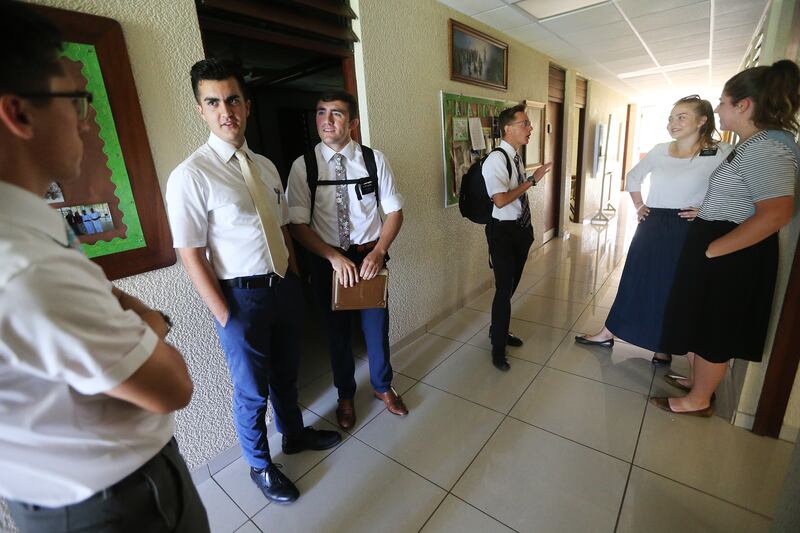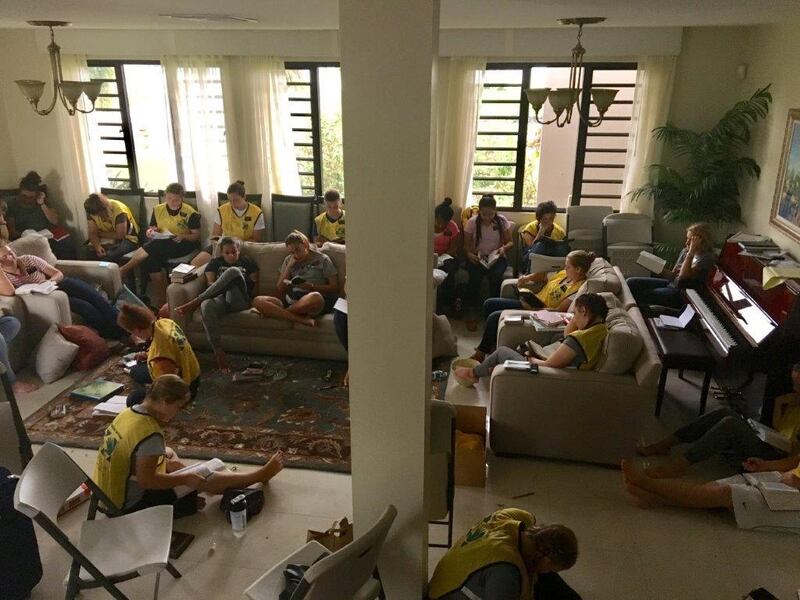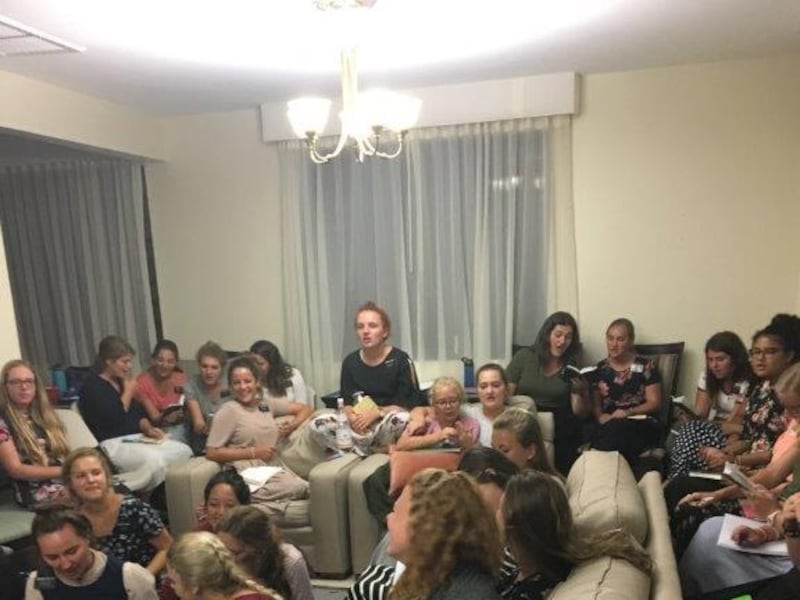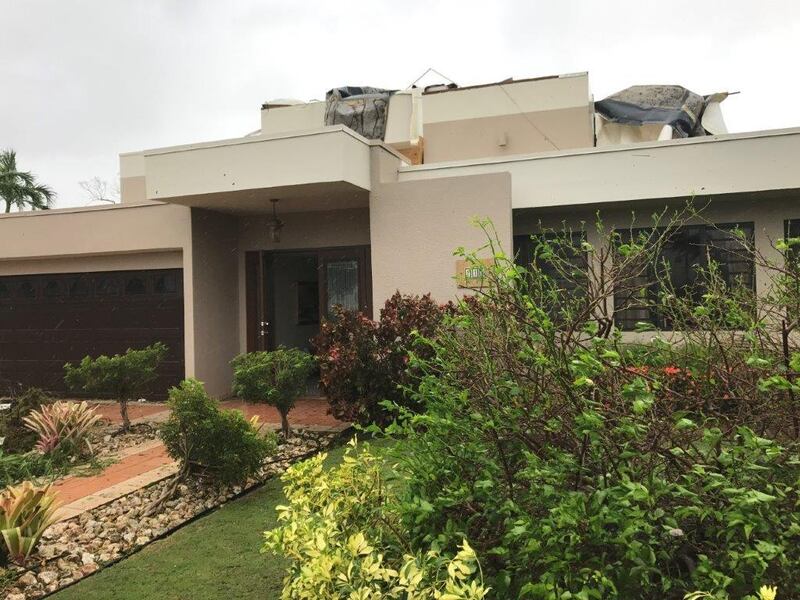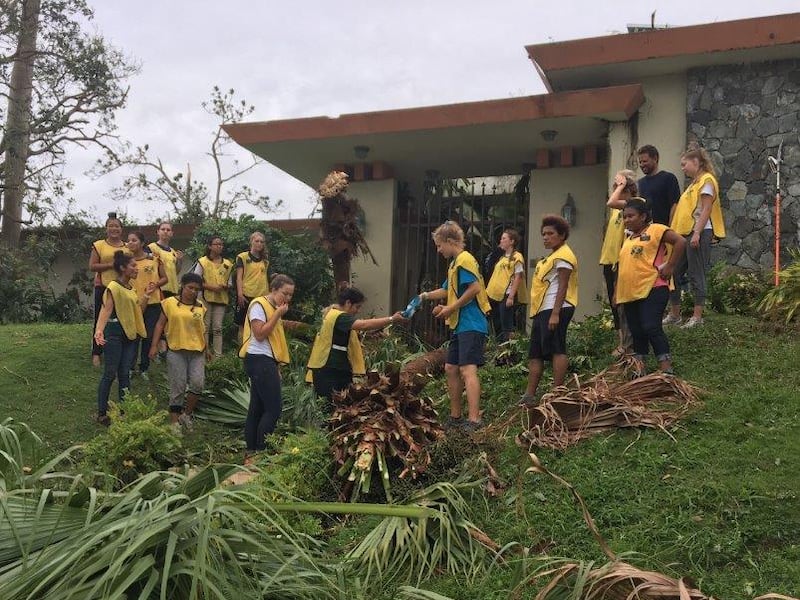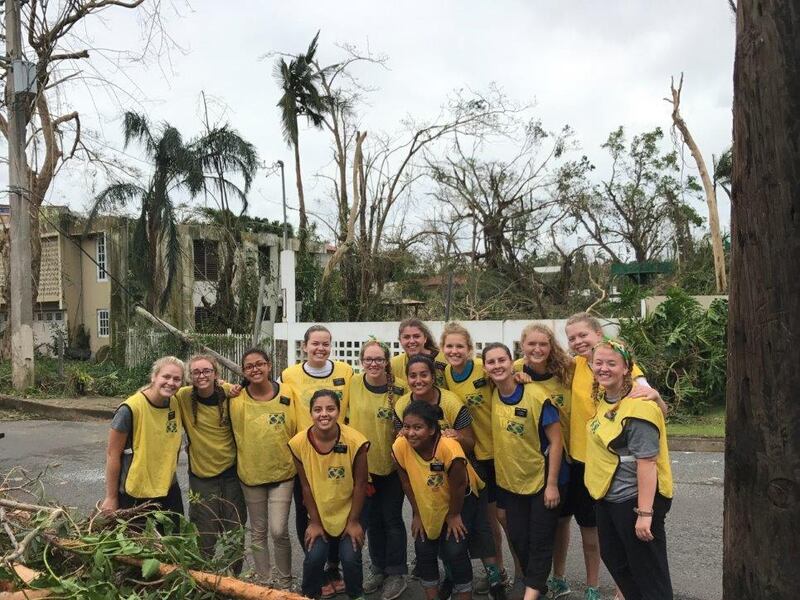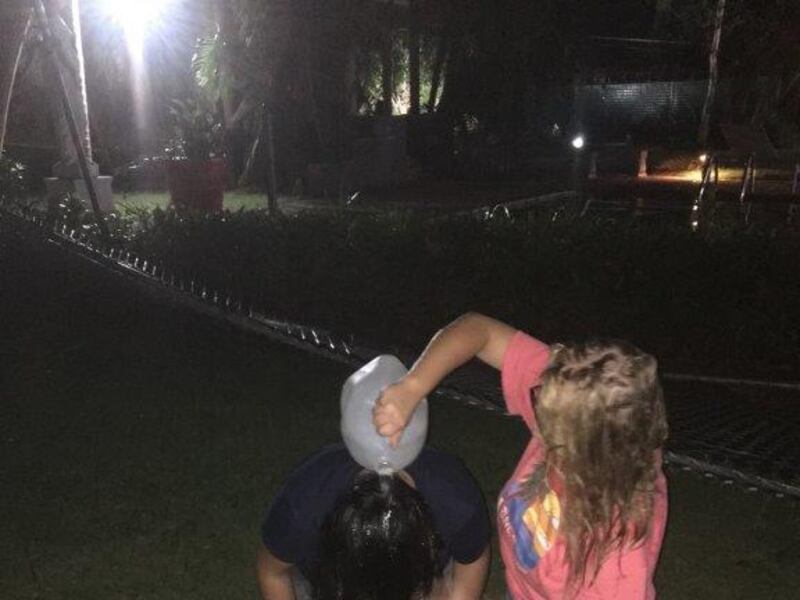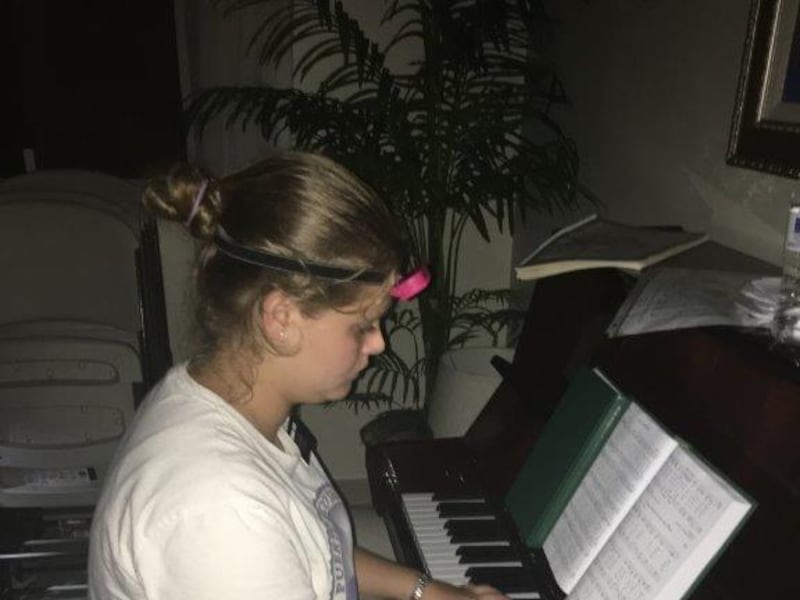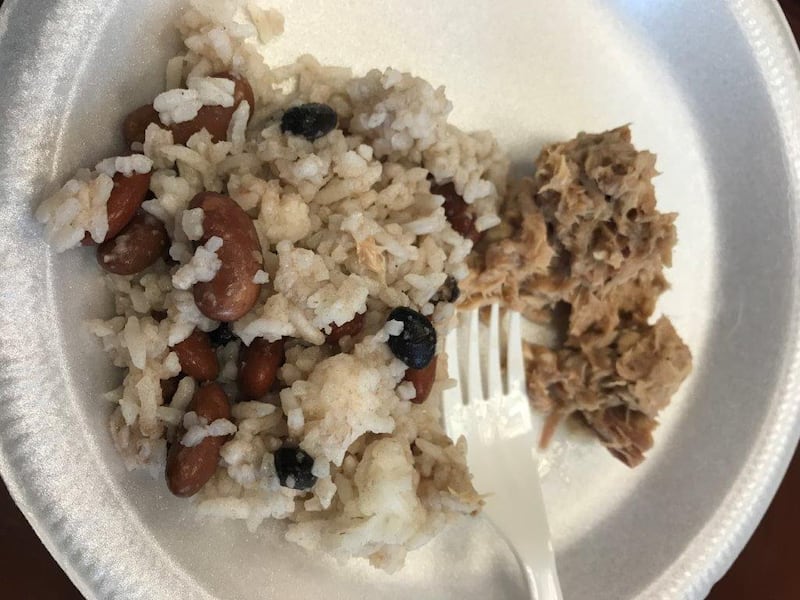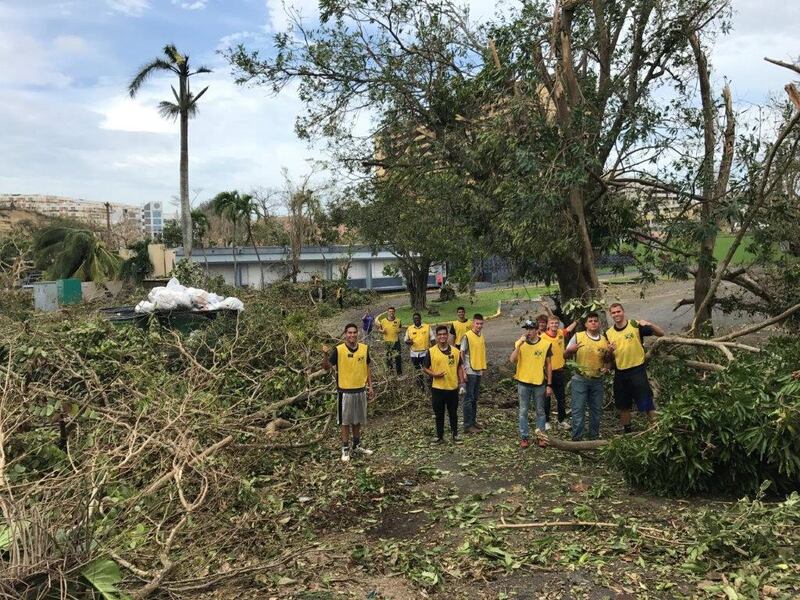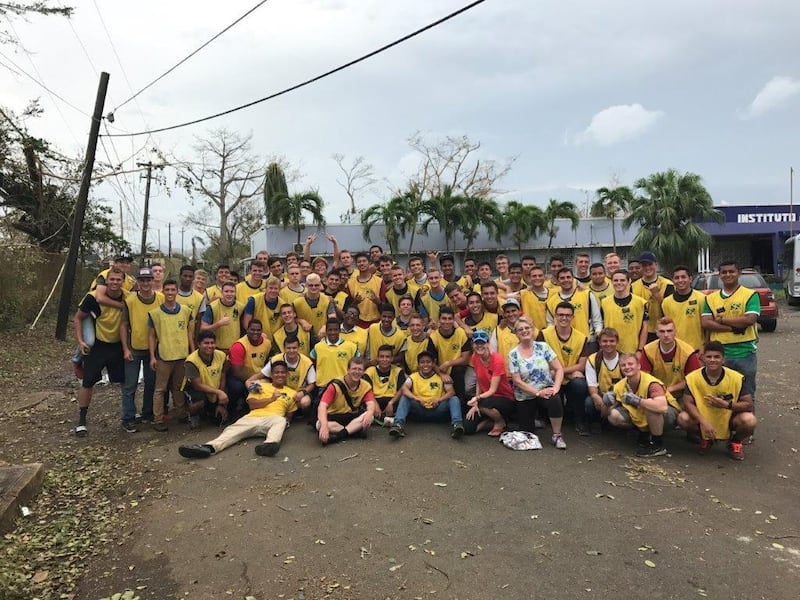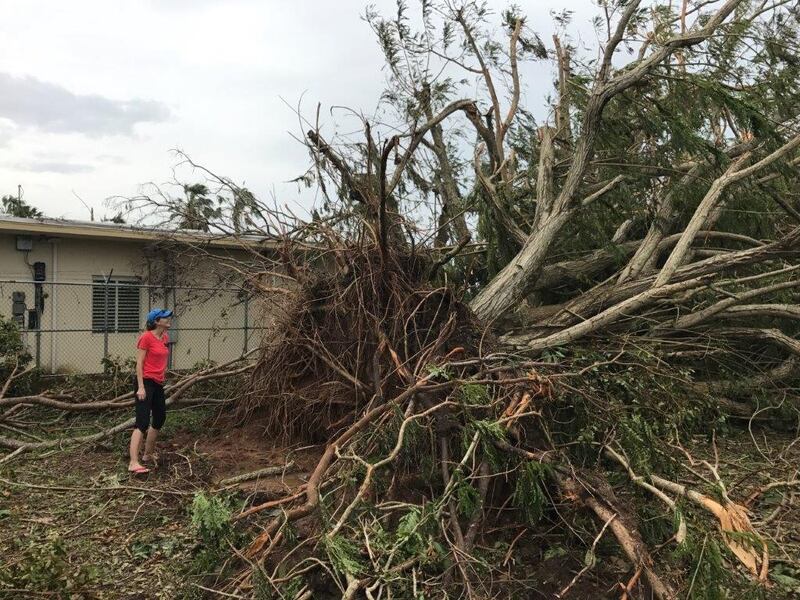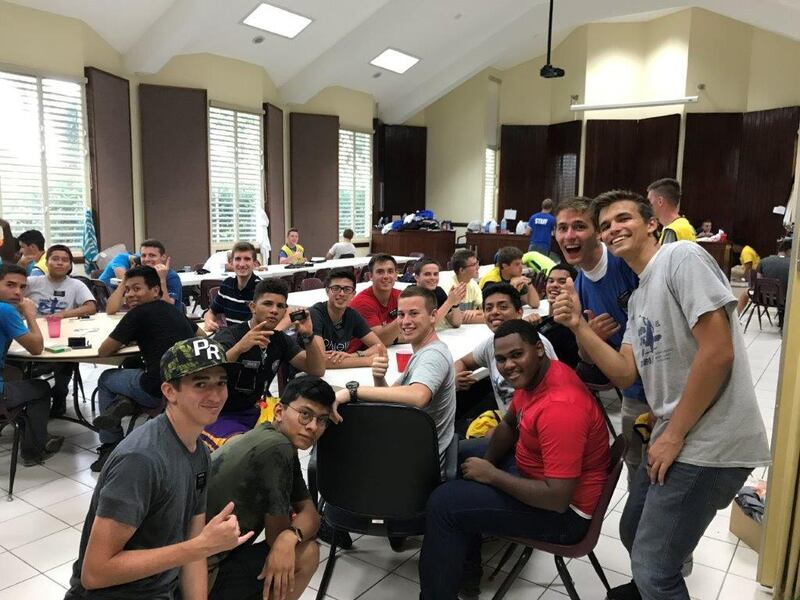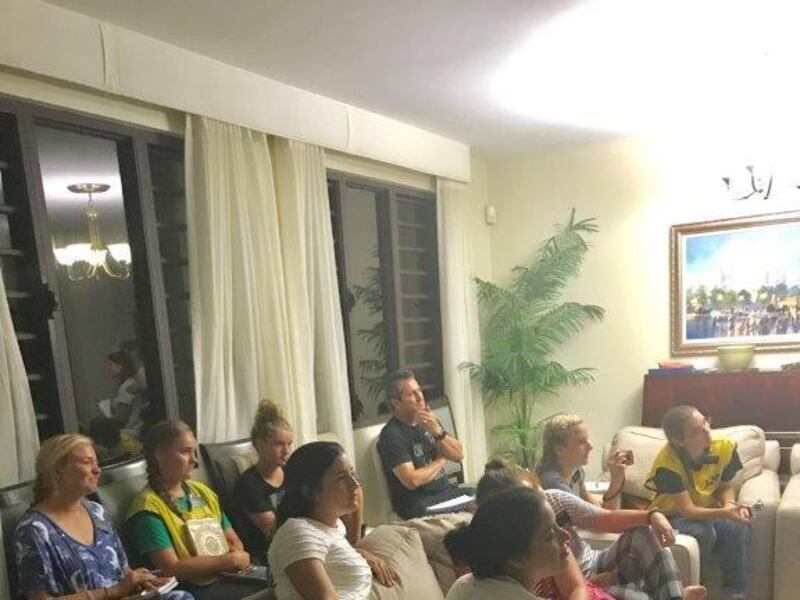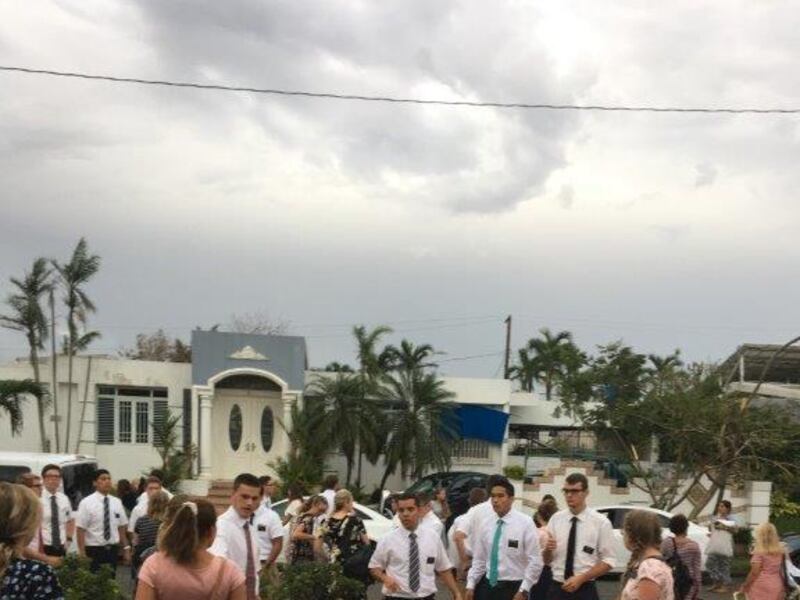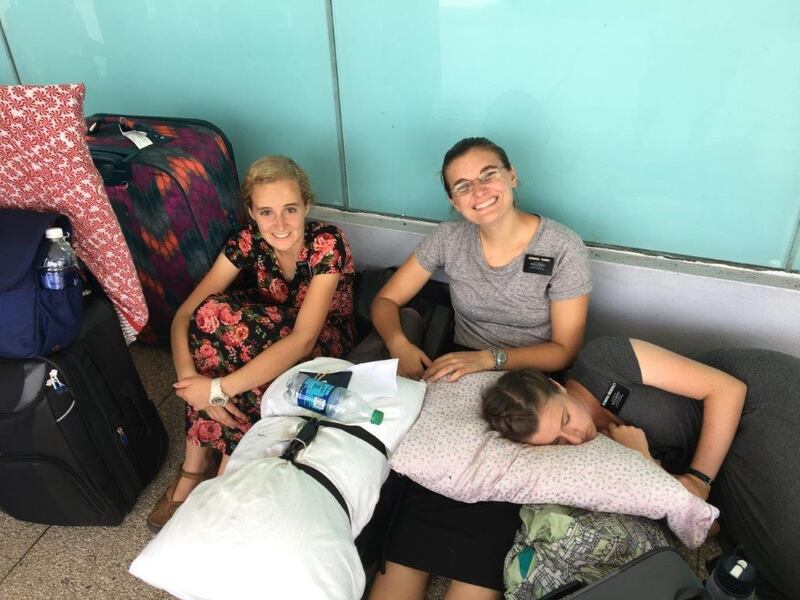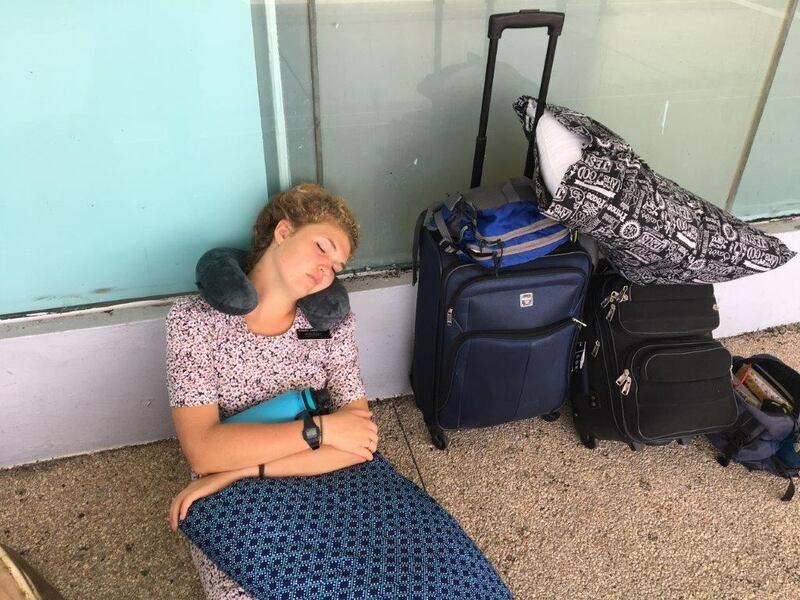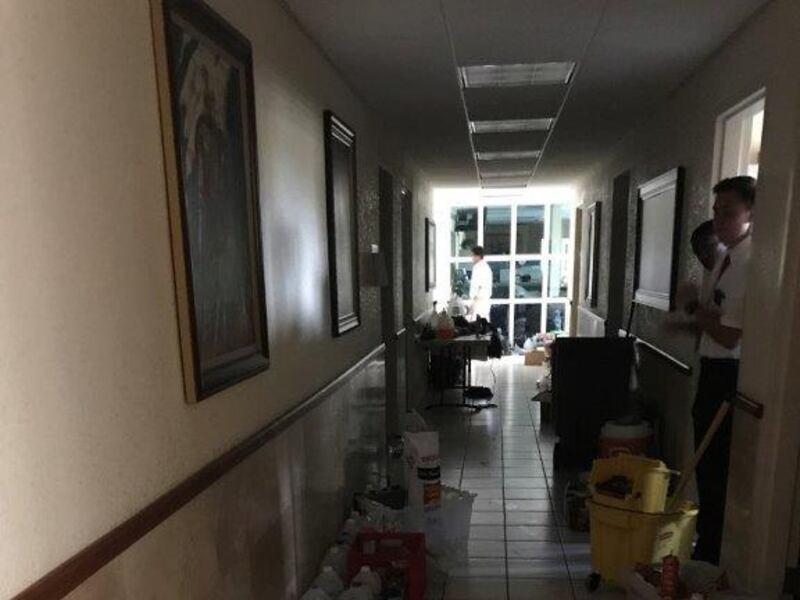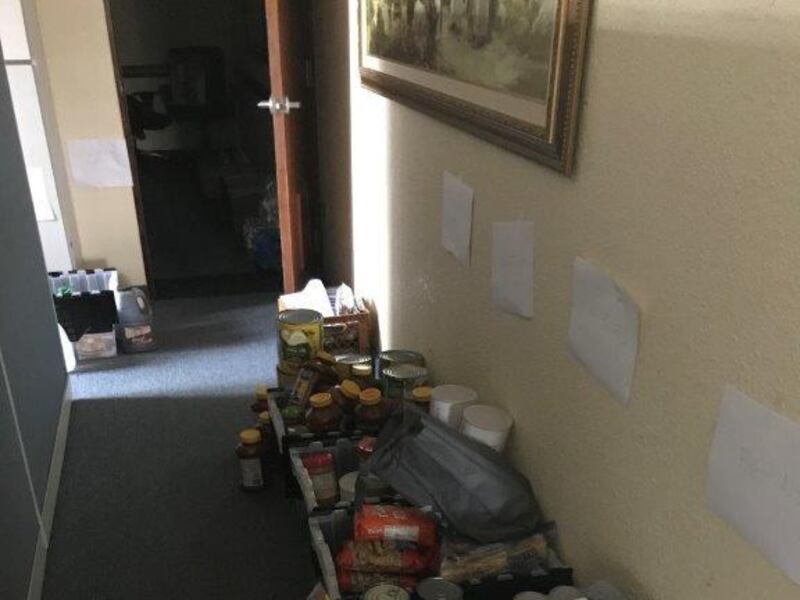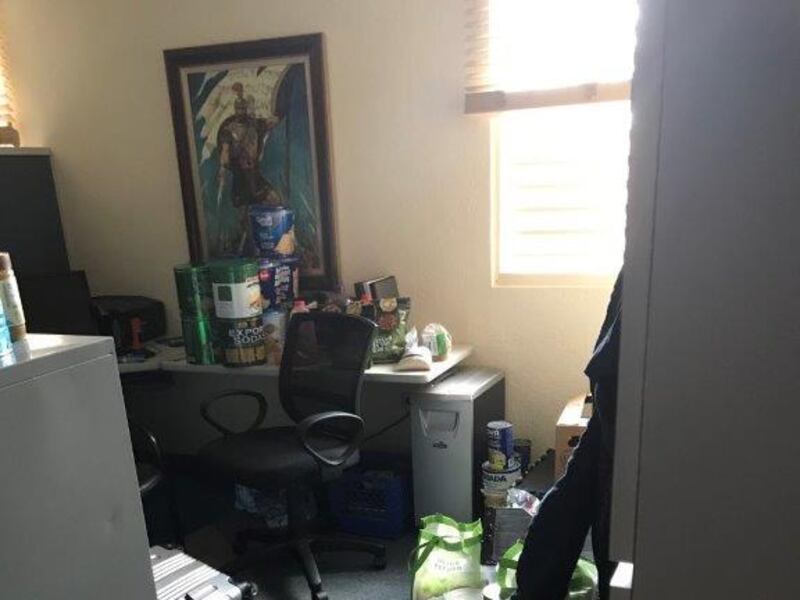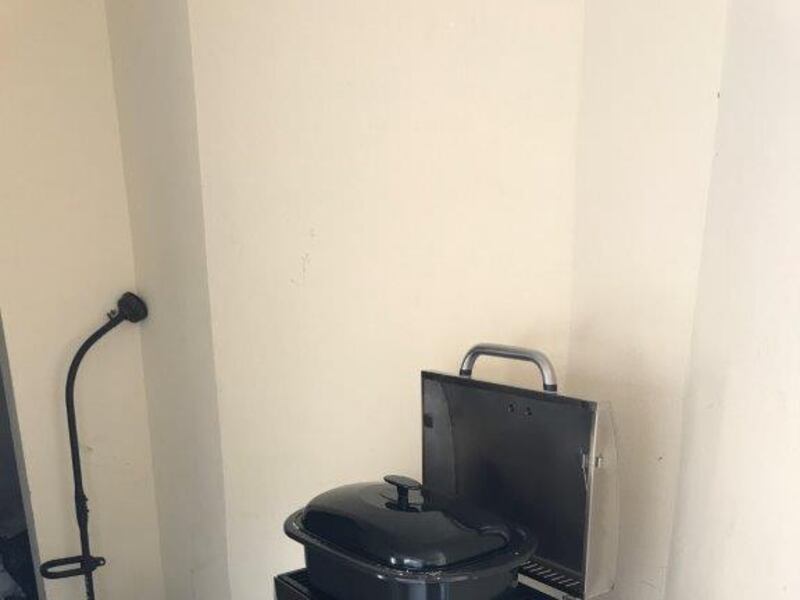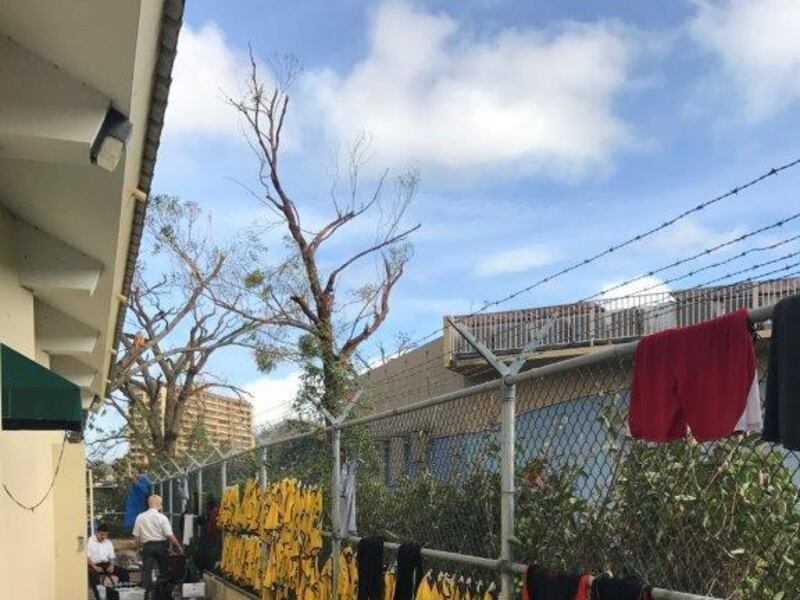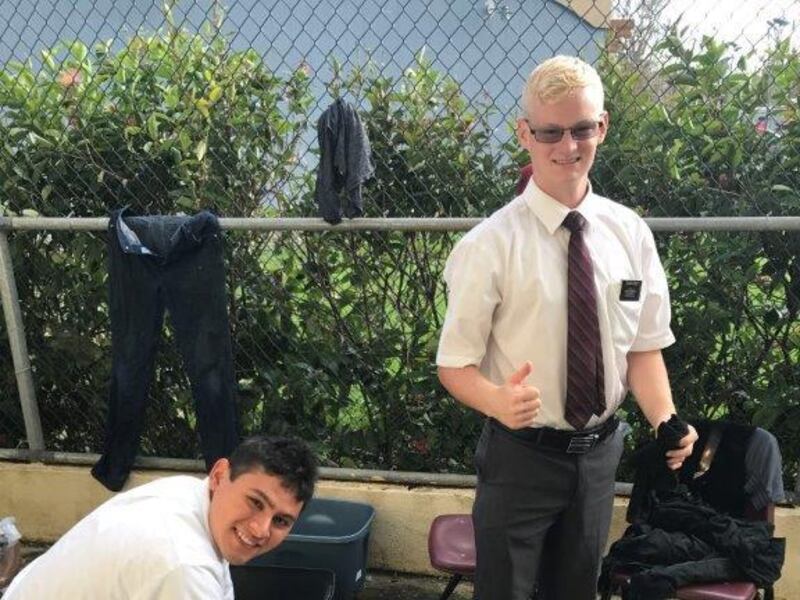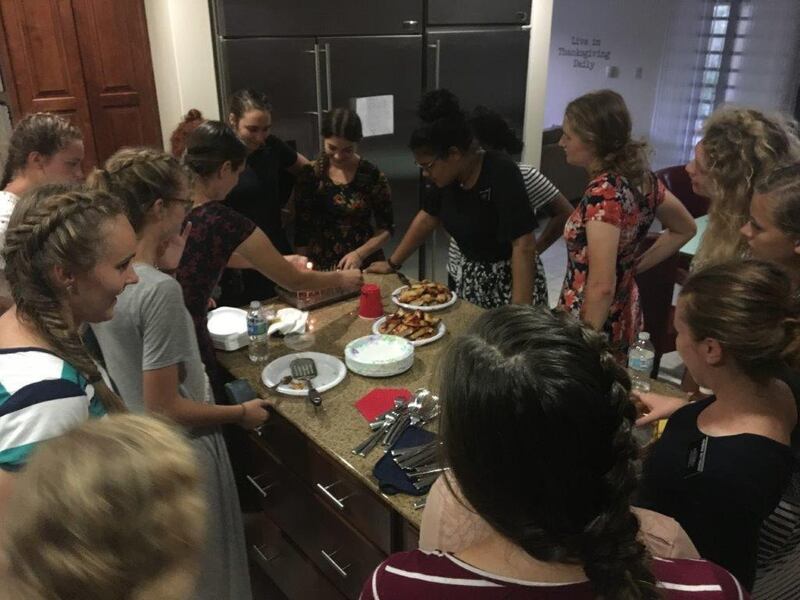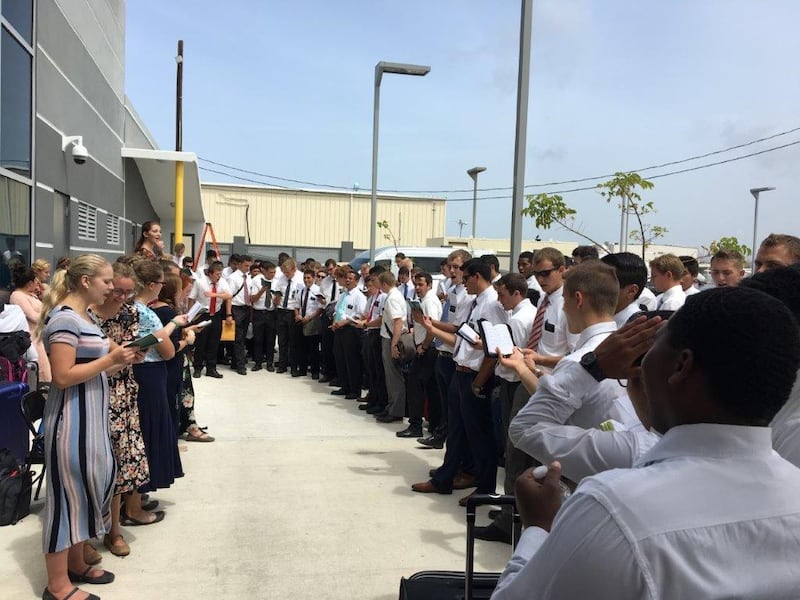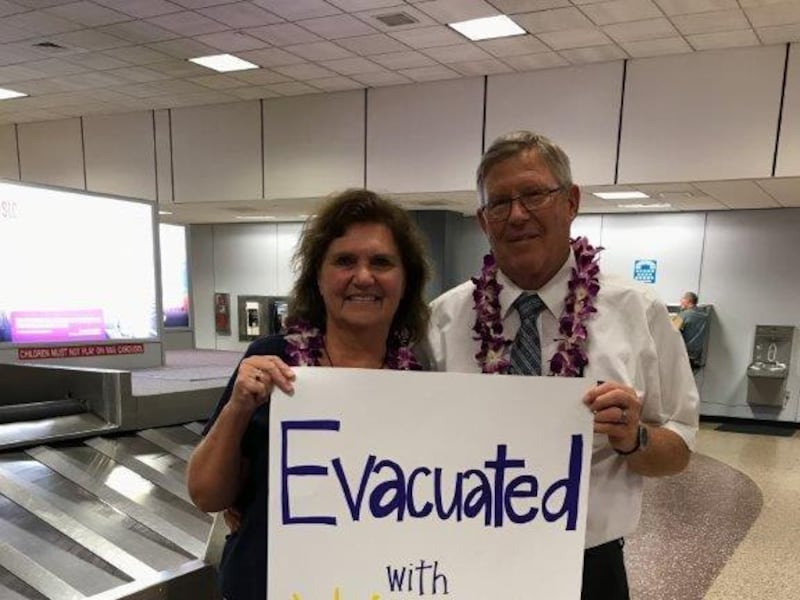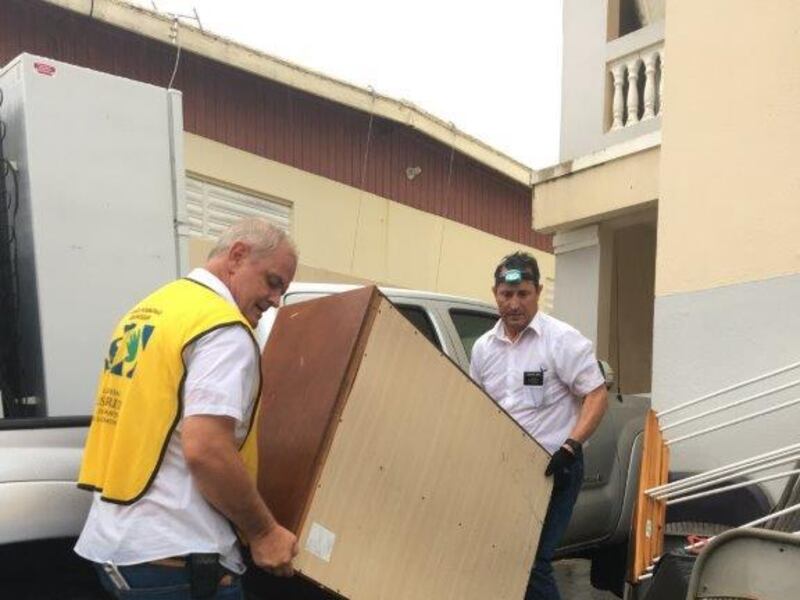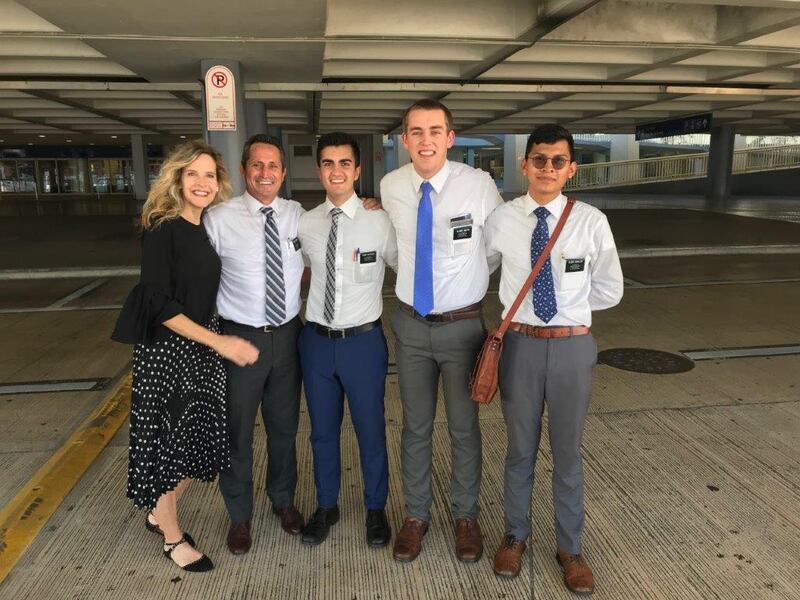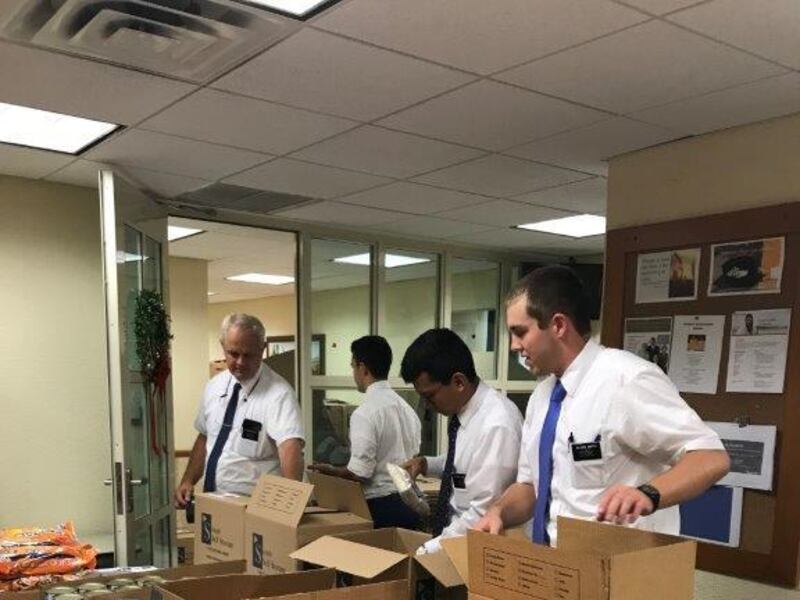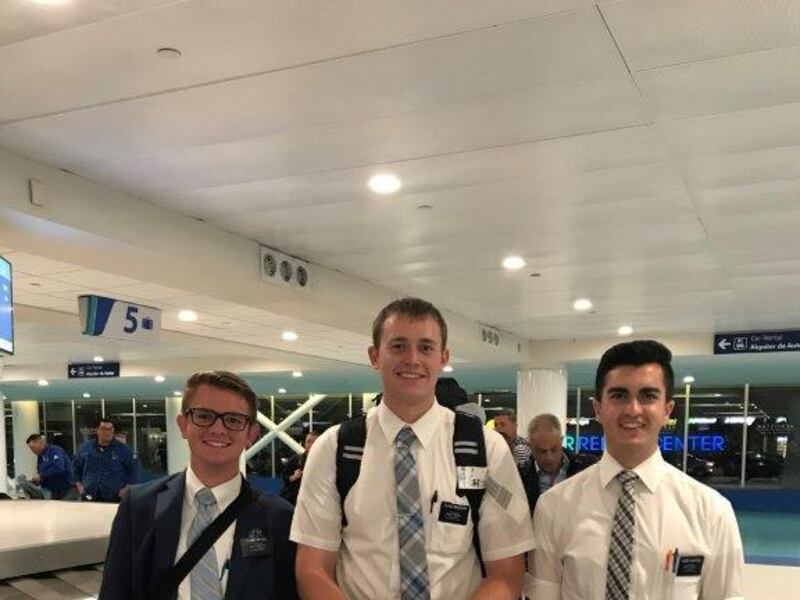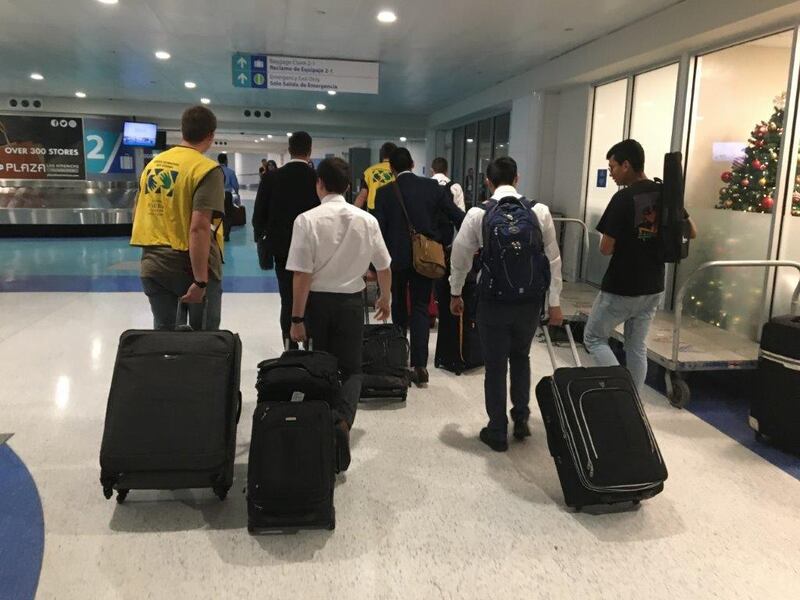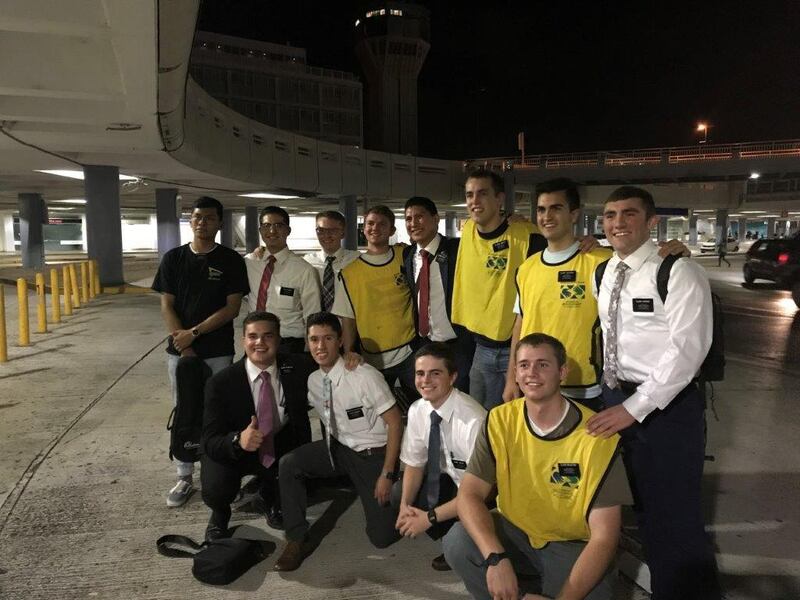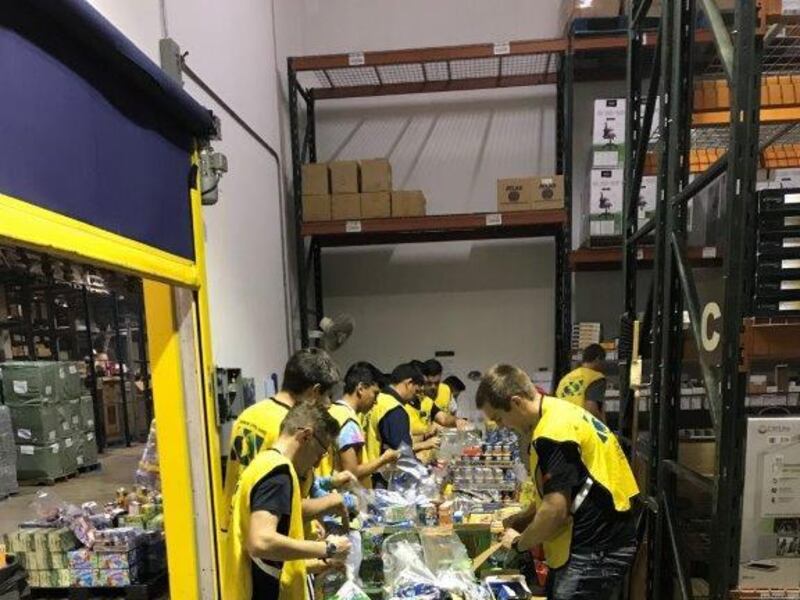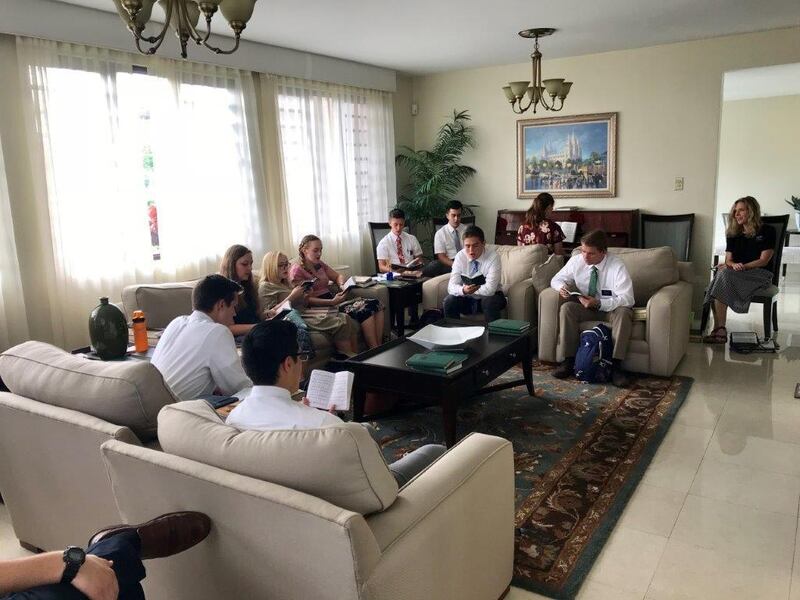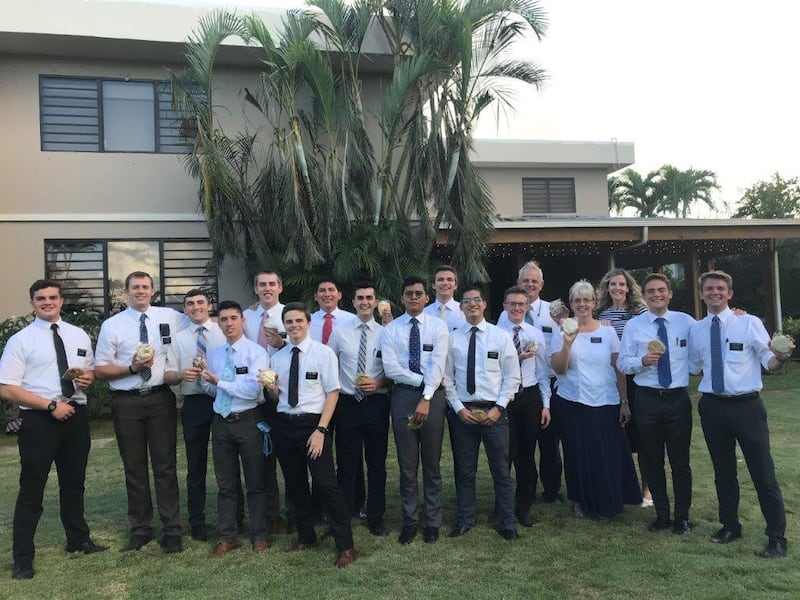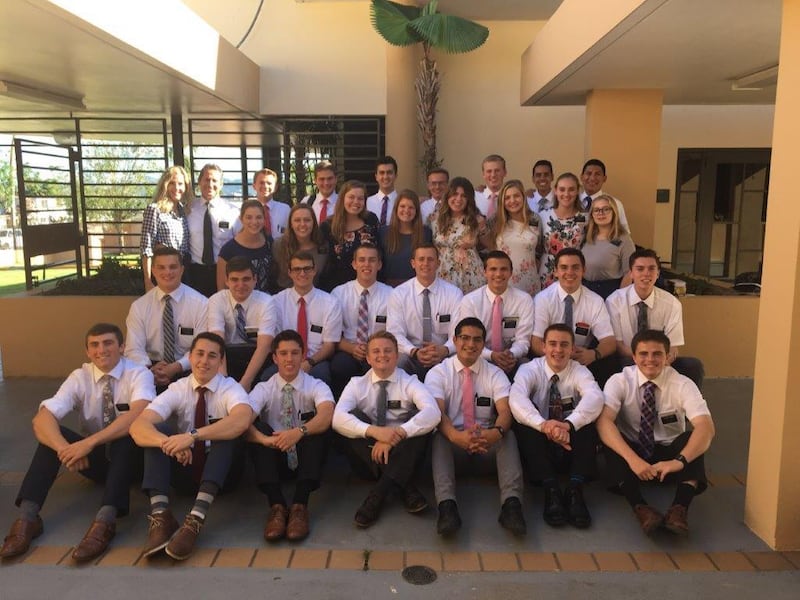SAN JUAN, Puerto Rico — The size of the main floor of the LDS Church’s Caparra meetinghouse in San Juan is easy to calculate, given each tile is 1-foot square. From the front of the pewless chapel to the back of the cultural hall, the distance is 51 tiles, and from side to side 31 tiles — 1,581 tiles total and 1,581 square feet. Now consider 100 Mormon missionaries on the tiled floor, with each young man allowed a two-tile-by-five-tile spot to place his pillow and perhaps a bed sheet to sleep at night.
Now consider 55 young women who are their missionary peers occupying a two-floor home used by the mission president and his wife. Located nearly four miles southeast of the meetinghouse, the five-bedroom San Juan home also includes an office for the president, complete with a “transfer board” — a magnet board where facial photos of the mission’s 155 missionaries are lined up according to companionship, area, district and zone.
For a day and a night, being huddled together in such tight confines might be a novelty. For a couple of days, it’s perhaps manageable. But for eight days in the wake of Hurricane Maria in late September 2017, it was a matter of survival for Puerto Rico San Juan Mission President David H. Smart and his wife, Sister Brenda Smart, and their 155 missionaries, who were left with little food, little water, little gas for generators, scant communication and absolutely no power anywhere on the island.
After the eight days, the missionaries were evacuated, leaving the Caribbean island without full-time missionaries representing The Church of Jesus Christ of Latter-day Saints for two-plus months. Eventually, missionaries have started trickling back — 14 in mid-December, 16 in late January and another 24 in mid-February, bringing the current total to 54 missionaries, or about a third of the pre-hurricane total.
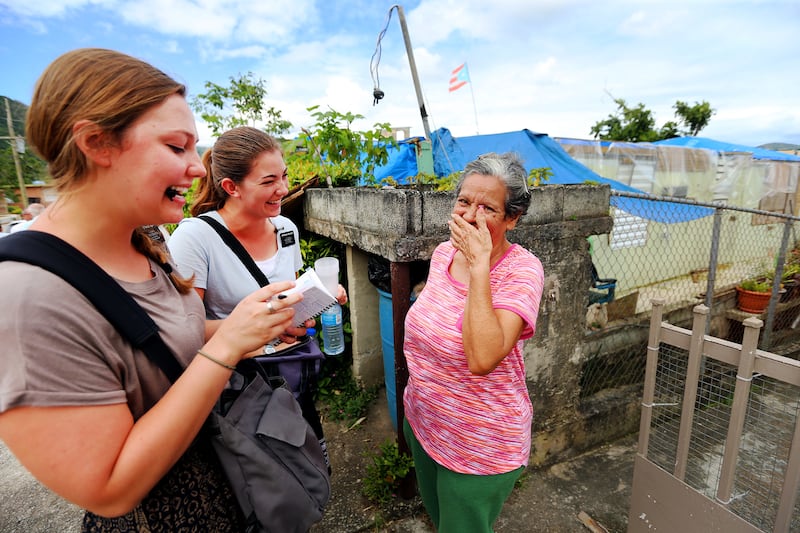
“We’re not a new mission, but we’re rebuilding a mission,” said President Smart, whose mission “complement” — the optimum number of missionaries to be assigned to a specific mission — has been readjusted from last year’s 155 to reach somewhere between 85 and 100 by later this year. “But the islands are not ready for them all.”
Tacked onto the transfer board in his office is an infrared satellite photo of Maria, with angriest dark reds of the hurricane’s center positioned over an outline of the island. It’s a reminder of what the Smarts and the Puerto Rico San Juan Mission experienced last fall over eight days and beyond.
Two hurricanes
Puerto Rico actually suffered through two hurricanes. On Sept. 6, Hurricane Irma skirted just to the north en route to pummeling Florida, with the San Juan missionaries told to hunker down in their apartments, keeping 72-hour kits nearby. Besides many being left among the 1 million without electricity, they were relatively unscathed, with normal routines resuming and the Smarts welcoming new missionaries a week later.
With Hurricane Maria targeting the island the following week, the Smarts woke up the day before its arrival with a singular impression: “Bring them home.” They called all missionaries to central San Juan — the 100 elders to the meetinghouse and the 55 sisters to the mission home — telling them to bring their 72-hour kits, a small suitcase or backpack with a change of clothes and their scriptures, journals and study materials.
The next day, on Sept. 20, Maria hit with its 155 mph winds, flash floods and storm surges, doubling as the 10th-worst Atlantic hurricane ever and Puerto’s Rico’s worst natural disaster on record. The storm paralyzed the U.S. island territory with 64 deaths, indescribable damage and debris and absolutely no electrical power.
“When the water and winds came,” said Elder Chandler Barker of Evanston, Wyoming, a first-week missionary weathering the storm in the meetinghouse, “it was like we were in a scripture story, and we really came together in mighty prayer.”
Besides those on the island during the two hurricanes, the Smarts had to worry about and remotely assist missionaries serving on other islands, including senior couples on St. Croix and St. Thomas of the U.S. Virgin Islands and a pair of elders on Dominica. “That required a lot of prayer,” said President Smart, with those evacuations including exits via a cruise ship and accompanying departing medical school students.
Meetinghouse and mission home
As the days started to mount after Maria’s devastation, President Smart worried about so many missionaries and so little space. “I thought it might turn into ‘The Lord of the Flies,’” he quipped.
He directed the missionaries into the neighborhoods and surrounding communities to help clean up and offer relief. They sometimes stood in long lines to purchase limited food and supplies or waited in mission vehicles for 10 to 12 hours to buy a $10 allotment of gasoline.
Meanwhile, the missionaries seemed to get along.
“We had a chance to get to know the other missionaries very well and to get to know a little bit about ourselves as well — what we can take on and the things we can learn from difficult situations,” said Elder Seth Gregory of Preston, Idaho.
Sister Smart recalled the sisters pulling together day after day — the cooking, the cleaning, the activities, the role-playing, the little musicals being performed, those playing the piano at night by the light of a battery-powered headlamp. “It really was one of the sweetest times of my life,” she said.
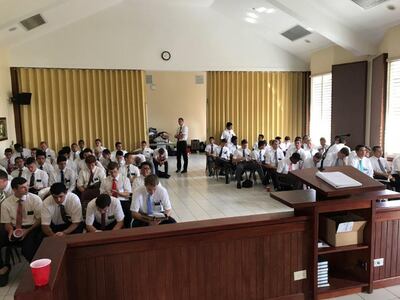
Sister Jordan Waters of Dallas described it “like a sleepover that we were having all together.”
Added Sister Makenna Fawcett of Ogden, Utah: “I’ll never forget the smell of 55 sister missionaries not showering for over a week. The last four days were hard — we were hungry, it was hot.”
President Smart noted the desperation of some over limited supplies, watching them pray for their food to last. “I think in the moment we were being sustained and being watched over, and I didn’t ever feel panicked,” the mission president said. “I knew we had to do something, but I was not panicked that in any moment that the Lord would not provide a solution.”
One of those solutions at the mission home was a wind-toppled fence bordering a neighbor’s property, which featured a swimming pool. With the neighbor’s blessing, Smart arranged for sisters to pack buckets of pool water into the mission home to be used for flushing toilets and washing clothes.
Missionaries still remember the limited food, the rationing and the creativity.
“We were eating some pretty gourmet food,” quipped Gregory. “Tuna and rice two times a day, cooked over a couple of gas stoves.”
Added Sister Smart: “At the end of the day, they said they were on their knees in gratitude, talking ‘How on earth are we able to do all that we’re doing in going out and serving and helping, when we looked back and saw that we had one granola bar for the entire day,’” she said. “But the Lord sustained us through that — we never felt hungry.”
Evacuations
After four days, the LDS Church arranged to get 35 sisters off the island, a number returning home to Mexico and other Latin American countries. With the airport still closed and without power, the returning sisters were issued handwritten tickets.
During the next four days, the Smarts and missionaries endured several on-then-off possible departures — ready, set and no-go. The church was able to charter the return leg of a flight delivering Red Cross and Federal Emergency Management Agency personnel to San Juan, alerting the Smarts to have missionary passports at hand and get to the airport the next day.
The mission president delivered the news — not just of the evacuation, but temporary mission reassignments for most and the unexpected release to return home for a handful of missionaries who had three months or less remaining to serve. “As soon as we said, ‘You, you’re going here, and you’re going there,’ it became very somber,” he recalled, “and even with the elders, you heard the crying.”
“That was an evening I’ll never forget because of the pain, the pain that was in my heart,” Sister Smart said, mindful of those being released. “They were sobbing. They couldn’t mentally wrap their minds around it — they didn’t have a chance to prepare. There wasn’t closure.
“There was one sister who — I can still hear her — it was almost like this gasp just like you had taken her most precious thing away from her. She collapsed right there on the ground into the arms of her companion.”
The next day, just before departing for the airport, the elders scrambled to proselytize one last time. “Everybody was out in the street, out to talk to us — we handed out seven Books of Mormon,” said Elder Tyson Santiago of Orem, Utah. “But it was also kind of heartbreaking, because we could see the people were so affected but we couldn’t stay, we couldn’t teach them in the most important moment of our missions.”
The Smarts and missionaries flew to Miami and were put up overnight in a hotel, returning to the airport at 4 a.m. as missionaries were sent to their new assignments — or to their homes.
Post-evacuation
Away from Puerto Rico for just shy of a week, the Smarts returned to join senior missionaries Elder Mark Maxfield and Sister Lynn Maxfield of Salt Lake City, who had stayed behind to clean out missionary apartments and empty long-since-powerless refrigerators. Salvageable personal belongings were collected and stacked in the mission offices.
“They had a very nasty job,” said President Smart, who joined the cleanings and closed 21 of the mission’s 51 missionary apartments. “Every mission president should have the opportunity to clean out their missionaries’ apartments — you learn a lot about them.”
The Smarts started inquiring later in October and well into November about the possibility of missionaries returning, but limited clean water on the island was a major concern.
“There wasn’t a day that went by when I didn’t think, ‘How are they, what are they doing, are they OK, are they staying strong?’” Sister Smart said.
Keeping busy helping local church and welfare leaders with recovery efforts, President Smart said his mind was often drawn to the absent missionaries. “You’ve got that transfer board that’s frozen in time,” he recalled, his voice cracking with emotion. “You look up at the missionaries and wonder which ones are going to come back and which ones might not. Those were the quiet moments.”
Missionaries return
Word finally came that a few missionaries would return to Puerto Rico — Dec. 14 was the day the first 14, all men, flew into San Juan.
“I cried all day long,” said Sister Smart, recalling a missionary mother working at the Denver airport who met a San Juan-bound missionary on a layover and snagged a cellphone photo to send to the Smarts. “For the first time, I allowed myself to think ‘They really are coming back,’ and I just looked at it and sat down and held it, like I was holding him. And I thought, ‘You’re almost here, you guys are almost here.’”
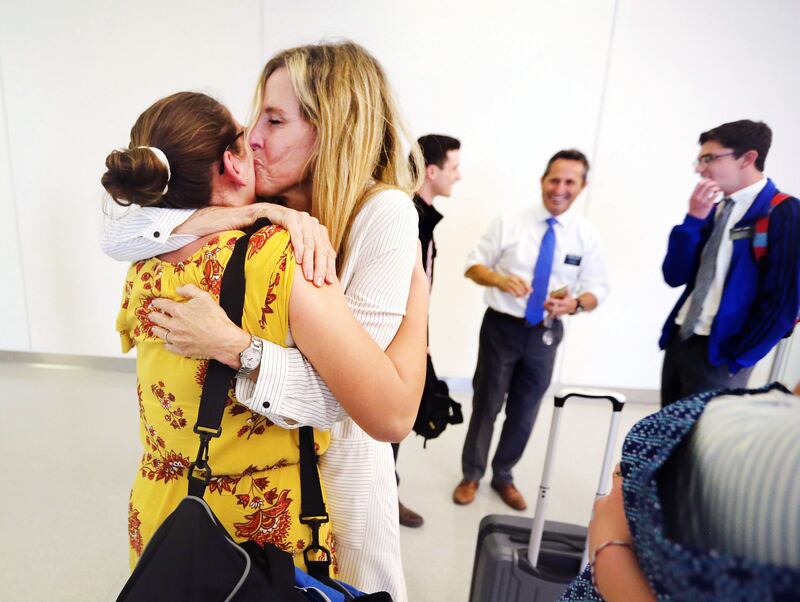
The Smarts arrived early at the airport, waiting for that first glimpse of missionaries descending down the escalator.
“I’ll admit it, I completely broke the rules and hugged them, because you just try not to — you try not to hug them when you’ve got that much joy,” Sister Smart said. “I’m OK with that — I won’t even ask for forgiveness — because that’s how it had to be for me. And if that even gives us a glimpse of what it’s going to be like to be reunited with our loved ones and our Father in Heaven, I could taste that — just a little bit.”
Elder Barker recalled the Smarts' greeting. “As tears filled both their eyes and all of ours as we got off the plane,” he said, “it was a new feeling of unity as we knew we were back to do the Lord’s work and start up the work on the island again.”
Yet Elder Vincent Autry of Lenexa, Kansas, remembered an anxious feeling. “Even though it was exciting, it was hard,” he said. “Because it was like, I want to do this and I really love it, but at the same time, it’s opening up your heart again, and I don’t want to have to shut it off again.”
Six weeks later, on Jan. 23, another group arrived — eight men and eight women. President Smart recalled attending a stake conference in Caguas soon after, watching one of the local members surprise one of the returning sisters.
“This dear sister (member) came up behind her and put her hands over her eyes, and then they turned around and saw each other for the first time,” he said. “Just to see the joy and the tears — if that’s happening, and I know it is across the island, there are just beautiful, beautiful experiences going on.”
He also remembered the words of one of the island’s five stake presidents: “For 30 years, we’ve never been without missionaries — now I know how instantly they can disappear.”
Little by little, they’re reappearing — on Feb. 20 and 21, another 24 elders and sisters, including several straight from the Dominican Republic missionary training center.
The missionaries could spend considerable time in aiding recovery efforts, and they’re equipped to do so, packing not only scriptures but work gloves, water-filtration bottles and yellow Mormon Helping Hands vests. But they’re finding increased proselytizing opportunities, as local members are more involved than ever in member-missionary work.
“What we’re doing as Christians, as disciples of Christ, is beginning to open people’s eyes and minds and hearts to the Savior,” Smart said.
Looking back and ahead
With Irma and Maria now six months in the past, some memories start to fade — and President Smart wants to avoid that. “I challenge the missionaries to write these experiences down — not only in your minds and your hearts but also on paper,” he said. “So that someday when you’re being challenged — because we all will be — you’ll have an anchor.”
A new hurricane season in the Caribbean is only a couple of months away. It starts just as the Smarts wind up their first year of a three-year leadership assignment. And what a year it has been for the mission president and his missionaries on the island.
“We’ll have a unique bond,” he said. “But I don’t want the hurricane to define us.”

